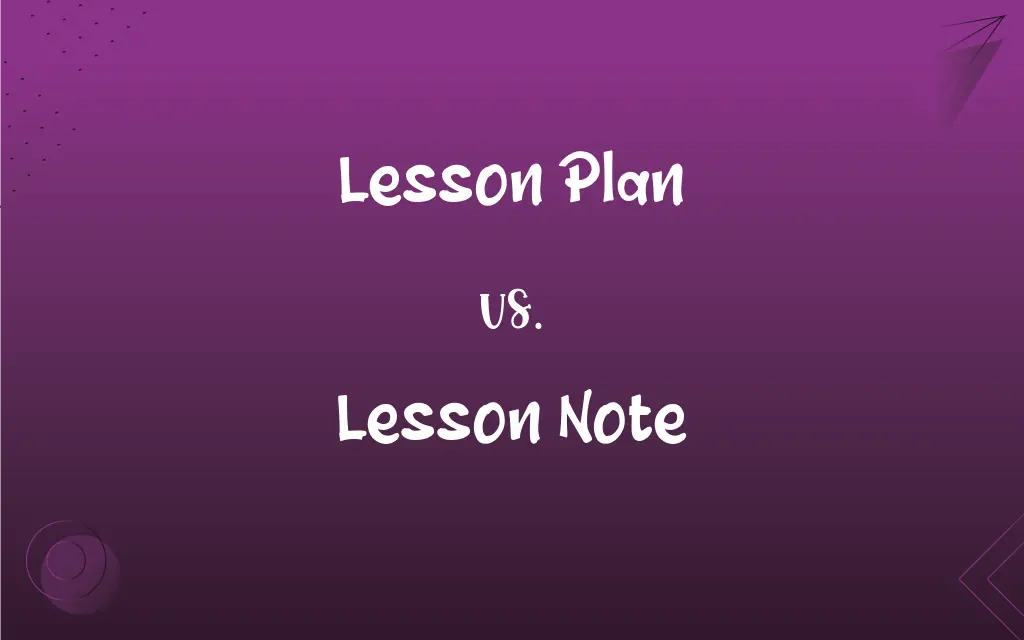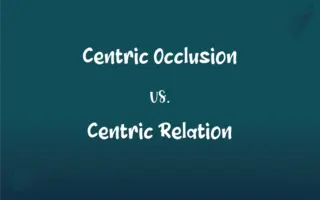Lesson Plan vs. Lesson Note: What's the Difference?
Edited by Aimie Carlson || By Janet White || Published on December 29, 2023
A lesson plan is a teacher's detailed guide for teaching a lesson, while lesson notes are the notes taken by students during or after a lesson.

Key Differences
Lesson plans are used by teachers to outline the structure and flow of a lesson. While, lesson notes are taken by students to summarize and remember key points from the lesson.
Lesson plans include objectives, materials, procedures, and assessment methods. Lesson notes typically contain summaries of the content discussed, personal insights, and questions.
Teachers prepare lesson plans before teaching to ensure a structured approach. Whereas, students create lesson notes during or after a lesson to aid their understanding and retention.
Lesson plans have a more formal and standardized format. Lesson notes vary in format, often depending on individual student preferences.
Lesson plans guide the teaching process, ensuring all necessary topics are covered. Lesson notes assist in the learning process, helping students to process and remember information.
ADVERTISEMENT
Comparison Chart
Purpose
Guide for teaching
Aid for learning
Content Elements
Objectives, materials, methods
Summaries, insights, questions
Creation Time
Prepared before class
Taken during/after class
Format
Formal and standardized
Informal and personalized
Educational Role
Structures the teaching process
Enhances understanding and retention
ADVERTISEMENT
Lesson Plan and Lesson Note Definitions
Lesson Plan
A blueprint for delivering educational content.
He reviewed the lesson plan to ensure all topics were covered.
Lesson Note
Contains personal insights and understandings.
His lesson note included questions he wanted to ask.
Lesson Plan
Outlines instructional goals and methodologies.
The lesson plan incorporated various interactive teaching methods.
Lesson Note
Often includes questions or clarifications.
Her lesson note had several questions for the next class.
Lesson Plan
Includes assessment strategies for student learning.
The lesson plan detailed how students' understanding would be evaluated.
Lesson Note
A tool used for revising and studying.
She referred to her lesson notes while preparing for the exam.
Lesson Plan
A roadmap for managing classroom activities.
The lesson plan helped her stay on track during the busy day.
Lesson Note
Summarizes key points from a lesson.
Her lesson note captured the main concepts of the lecture.
Lesson Plan
A structured guide for conducting a lesson.
Her lesson plan included a detailed timeline of activities.
Lesson Note
Reflects on what was learned in class.
The lesson note helped him remember the discussion points.
FAQs
Who prepares a lesson plan?
The teacher prepares it before the lesson.
When are lesson notes created?
During or after the lesson by students.
Can lesson plans be reused?
Yes, they can be adapted and reused for similar lessons.
What is a lesson plan?
A detailed guide created by teachers for conducting a lesson.
Why are lesson notes important for students?
They aid in understanding and retaining lesson content.
What does a lesson plan typically include?
Objectives, materials, procedures, and assessment methods.
What are common elements in lesson notes?
Summaries, personal insights, and questions.
How detailed should a lesson plan be?
It varies but should be sufficiently detailed to guide the lesson.
What is a lesson note?
Notes taken by students summarizing key points from a lesson.
What's the role of a lesson plan in student assessment?
It outlines how student understanding and progress will be evaluated.
How does a lesson plan help teachers?
It ensures a structured and effective teaching approach.
Can lesson notes be digital?
Yes, many students take notes on laptops or tablets.
Should lesson notes include personal opinions?
Yes, personal insights can enhance understanding.
Is technology used in creating lesson plans?
Yes, various software and tools can be used for planning.
How often should lesson plans be reviewed?
Regularly, to ensure they meet educational objectives.
Are visuals important in lesson notes?
Visuals can be helpful for remembering and understanding concepts.
Are lesson notes formal or informal?
They are generally informal and personalized.
Do lesson plans evolve over time?
Yes, they often change based on teaching experiences and feedback.
Should lesson notes be shared with classmates?
Sharing can be beneficial but depends on individual preferences.
How can lesson notes be improved?
By actively listening, organizing thoughts, and asking questions.
About Author
Written by
Janet WhiteJanet White has been an esteemed writer and blogger for Difference Wiki. Holding a Master's degree in Science and Medical Journalism from the prestigious Boston University, she has consistently demonstrated her expertise and passion for her field. When she's not immersed in her work, Janet relishes her time exercising, delving into a good book, and cherishing moments with friends and family.
Edited by
Aimie CarlsonAimie Carlson, holding a master's degree in English literature, is a fervent English language enthusiast. She lends her writing talents to Difference Wiki, a prominent website that specializes in comparisons, offering readers insightful analyses that both captivate and inform.






































































